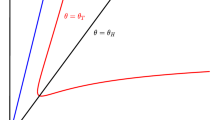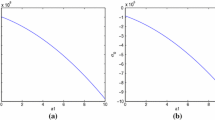Abstract
A simple stochastic description of a model of a predator-prey system is given. The evolution of the system is described by means of Itô's stochastic differential equations (SDEs), which are the natural stochastic generalization of the Lotka-Volterra deterministic differential equations. Since these SDEs do not satisfy the usual conditions for the existence and uniqueness of the solution, we state a theorem of existence; moreover we study the stability of the equilibrium point and perform a computer simulation to study the behaviour of the trajectories of solutions with given initial data and to estimate first and second moments.
Similar content being viewed by others
References
Abundo, M., Rossi C.: Numerical simulation of a stochastic model for cancerous cells submitted to chemotherapy. J. Math. Biol. 27, 81–90 (1989)
Andersen, P. K., Borgan, Ø.: Counting process models for life history data. Scand. J. Statist. 12, 97–158 (1985)
Arnold, L.: Stochastic differential equations: theory and applications. New York: Wiley 1974
Arnold, L., Lefever, R. (eds.) Stochastic non linear systems in physics, chemistry and biology. (Springer Series in Synergetics) Berlin Heidelberg New York: Springer 1981
Barra, M., Del Grosso, G., Gerardi, A., Koch, G., Marchetti, F.: Some basic properties of stochastic population models. (Lect. Notes Biomath., vol. 32, pp. 155–164) Berlin Heidelberg New York: Springer 1978
Billard, L. On Lotka-Volterra predator-prey models. J. Appl. Probab. 14, 375–381 (1977)
Billingsley, P.: The Lindeberg-Levy theorem for martingales. Proc. Am. Math. Soc. 12, 788, 792 (1961)
Billingsley, P.: Convergence of probability measures. New York: Wiley 1968
Capocelli, R. M., Ricciardi, L. M.: A diffusion model for population growth in random environment. Theor. Popul. Biol. 5, 28–45 (1974)
Crow, J. F., Kimura, M.: An introduction to population genetics theory. New York: Harper and Row 1970
Feldman, M. W., Roughgarden, J.: A population's stationary distribution and chance of extinction with remarks on the theory of species packing. Theor. Popul. Biol. 7, 197–207 (1975)
Ferrante, L., Koch, G.: An application of Liapunov techniques to stochastic population models. Report Dipartimento di Matematica University di Roma, ‘La Sapienza’
Gihman, I. I., Skorohod, A. V.: Stochastic differential equations. Berlin Heidelberg New York: Springer 1972
Goel, N. S., Maitra, S. C., Montroll, E. W.: On the Volterra and other nonlinear models of interacting populations. Rev. Modern Phys. 43, 241–276 (1971)
Hinkley, S. W., Tsokos, C. P.: A stochastic model for chemical equilibrium. Math. Biol. 21, 241–276 (1971)
Khas'minskiy, R. Z.: Stability of systems of differential equations in the presence of random disturbances (in Russian). Moscow: Nauka Press 1969
Koch, G.: Stochastic models in biology I, II. Systems Anal. Modelling Simulation 1, 27–33; 151–168 (1984)
Kushner, H. J. Stability and existence of diffusions with discontinuous or rapidly growing drift terms. J. Differ 11, 156–168 (1972)
Lewontin, R. C., Cohen D.: On population growth in randomly varying environment. Proc. Nat. Acad. Sci. 62, 1056–1060 (1969)
Ludwig, D.: Persistence of dynamical systems under random perturbations. SIAM Rev. 15, 605–640 (1975)
Nobile, A. G., Ricciardi, L. M.: Growth and extinction in random environment. (Second International Conference on Information Science and Systems, Univ. Patras, Patras, 1979), vol. III, pp. 455–465. Dordrecht: Reidel 1980
May, R. M.: Stability and complexity in model ecosystems. Princeton University Press 1973
Rescigno, A., Richardson, I. W.: The deterministic theory of population dynamics. In: Rosen R. (ed.) Foundation of mathematical biology, vol. 3. New York: Academic Press 1981
Ricciardi, L. M.: Diffusion process and related topics in biology. (Lect. Notes Biomath., vol. 14) Berlin Heidelberg New York: Springer 1977
Ricciardi, L. M.: Stochastic equations in neurobiology and population biology. (Lect. Notes Biomath., vol. 39, 248–263) Springer Verlag (1980)
Rumelin, W.: Numerical treatment of stochastic differential equations. SIAM J. Numer. Anal. 19, 604–613 (1982)
Author information
Authors and Affiliations
Rights and permissions
About this article
Cite this article
Abundo, M. A stochastic model for predator-prey systems: basic properties, stability and computer simulation. J. Math. Biol. 29, 495–511 (1991). https://doi.org/10.1007/BF00164048
Received:
Revised:
Issue Date:
DOI: https://doi.org/10.1007/BF00164048




